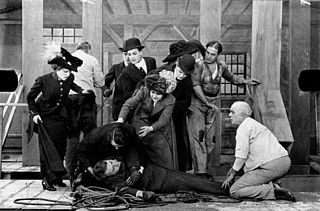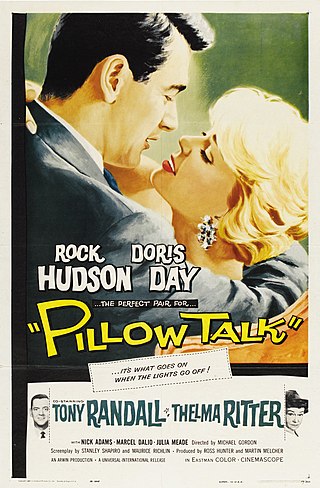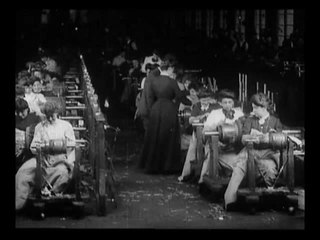Related Research Articles

A Corner in Wheat is a 1909 American short silent film which tells of a greedy tycoon who tries to corner the world market in wheat, destroying the lives of the people who can no longer afford to buy bread. It was directed by D. W. Griffith and adapted by Griffith and Frank E. Woods from a novel and a short story by Frank Norris, titled The Pit and A Deal in Wheat.

Safety Last! is a 1923 American silent romantic-comedy film starring Harold Lloyd. It includes one of the most famous images from the silent-film era: Lloyd clutching the hands of a large clock as he dangles from the outside of a skyscraper above moving traffic. The film was highly successful and critically hailed, and it cemented Lloyd's status as a major figure in early motion pictures. It is still popular at revivals, and it is viewed today as one of the great film comedies.

Pillow Talk is a 1959 American romantic comedy film in CinemaScope directed by Michael Gordon and starring Rock Hudson and Doris Day. The supporting cast features Tony Randall, Thelma Ritter, Nick Adams, Allen Jenkins, Marcel Dalio and Lee Patrick. The film was written by Russell Rouse, Maurice Richlin, Stanley Shapiro, and Clarence Greene.
The Thanhouser Company was one of the first motion picture studios, founded in 1909 by Edwin Thanhouser, his wife Gertrude and his brother-in-law Lloyd Lonergan. It operated in New York City until 1920, producing over a thousand films.

Westinghouse Works, 1904 is a collection of American short silent films, each averaging about three minutes in length. The films were taken from April 18, 1904, to May 16, 1904, in Pittsburgh, Pennsylvania, and document various Westinghouse manufacturing plants. They were made by G. W. "Billy" Bitzer of the American Mutoscope and Biograph Company, were shown at the Westinghouse Auditorium at the 1904 St. Louis World's Fair, and may have been made for that purpose. At least 29 films were produced and 21 remain in the collection which is now a part of the National Film Registry of the Library of Congress.

Empire is a 1965 American black-and-white silent art film by Andy Warhol. When projected according to Warhol's specifications, it consists of eight hours and five minutes of slow motion footage of an unchanging view of New York City's Empire State Building. The film does not have conventional narrative or characters, and largely reduces the experience of cinema to the passing of time. Warhol stated that the purpose of the film was "to see time go by."

An American in Paris is a 1951 American musical romantic comedy film inspired by the 1928 jazz-influenced symphonic poem An American in Paris by George Gershwin. Starring Gene Kelly, Leslie Caron, Oscar Levant, Georges Guétary, and Nina Foch, the film is set in Paris, and was directed by Vincente Minnelli from a script by Alan Jay Lerner. The music is by George Gershwin, with lyrics by his brother Ira, with additional music by Johnny Green, and Saul Chaplin, the music directors.

Actuality film is a non-fiction film genre that uses footage of real events, places, and things, a predecessor to documentary film. Unlike documentaries, actuality films are not structured into a larger narrative or coherent whole. During the era of early cinema, actualities—usually lasting no more than a minute or two and usually assembled together into a program by an exhibitor—were just as popular and prominent as their fictional counterparts. The line between "fact" and "fiction" was not as prominent in early cinema as it would become once documentaries became the predominant non-fiction filmmaking form. Actuality as a film genre is related to still photography.

The National Recording Registry is a list of sound recordings that "are culturally, historically, or aesthetically significant, and/or inform or reflect life in the United States." The registry was established by the National Recording Preservation Act of 2000, which created the National Recording Preservation Board, whose members are appointed by the Librarian of Congress. The recordings preserved in the United States National Recording Registry form a registry of recordings selected yearly by the National Recording Preservation Board for preservation in the Library of Congress.
Frederick S. Armitage was an early American motion picture cinematographer and director, working primarily for the American Mutoscope and Biograph Company. Often identified as "F.S. Armitage" in AM&B paperwork, Armitage had a hand in creating more than 400 often very short subjects for AM&B in the days where its films were made as much for the hand-crank operated Mutoscope device as for projection. Several of Armitage's subjects stand out from the company's regular routine of actualities and comic skits in their innovative use of camerawork, superimpositions, time-lapse photography and other effects then new to the art of film-making.

The National Film Registry (NFR) is the United States National Film Preservation Board's (NFPB) collection of films selected for preservation, each selected for its historical, cultural and aesthetic contributions since the NFPB's inception in 1988.

The Morris A. Mechanic Theatre was a playhouse at 1 South Charles Street that was part of the Charles Center of Baltimore, Maryland. The theatre was built by and named for owner Morris A. Mechanic who operated a number of theatres in the city such as The Stanton Theatre, Ford's Grand Opera House, the Centre Theatre, and the Century and Valencia Theatres, all of which have since been demolished except for the Centre which the exterior has been restored and the interior has been repurposed as classroom and studio space for Maryland Institute College of Art and Johns Hopkins University film programs. The Mechanic theatre was demolished in 2014.

The Maniac Cook is a 1909 American silent thriller film produced by the Biograph Company of New York, directed by D. W. Griffith, and starring Anita Hendrie in the title role. Principal cast members also include Harry Solter and Marion Leonard.

Edgar Allen Poe [sic] is a 1909 American silent drama film produced by the Biograph Company of New York and directed and co-written by D. W. Griffith. Herbert Yost stars in this short as the 19th-century American writer and poet Edgar Allan Poe, while Linda Arvidson portrays Poe's wife Virginia. When it was released in February 1909 and throughout its theatrical run, the film was consistently identified and advertised with Poe's middle name misspelled in its official title, using an "e" instead of the correct second "a". The short was also originally shipped to theaters on a "split reel", which was a single reel that accommodated more than one film. This 450-foot drama shared its reel with another Biograph short, the 558-foot comedy A Wreath in Time. Prints of both films survive.

A Wreath in Time is a 1909 American silent comedy film written and directed by D. W. Griffith, produced by the Biograph Company of New York City, and co-starring Mack Sennett and Florence Lawrence. At its release in February 1909, the short was distributed to theaters on a "split reel", which was a single reel that accommodated more than one film. A Wreath in Time shared its reel with another Biograph short also directed by Griffith, the drama Edgar Allen Poe [sic]. Original paper rolls of contact prints of both motion pictures, as well as safety-stock copies of the two films, are preserved in the Library of Congress.

Lime Kiln Field Day is a 1913 American black-and-white silent film produced by the Biograph Company and Klaw and Erlanger. Unnamed, unassembled, and abandoned by its producers during post-production, the original footage was saved when Biograph donated its vaults to the Museum of Modern Art in 1938. It is considered to be the oldest surviving feature film with an all-Black cast.

The Terrace Theatre was located at 3508 France Avenue North in Robbinsdale, Minnesota. Upon its opening on May 23, 1951, the Terrace received critical acclaim for its “bold architectural lines [and] extensive patron services.” The 1,299-seat theater, designed in the mid-century modern style by the Minneapolis architectural firm of Liebenberg & Kaplan (L&K) for movie exhibitors Sidney and William Volk, was a popular Twin Cities destination for nearly fifty years. It changed hands in 1980 and again in 1987, when it was remodeled from a single-screen auditorium into three screens by dividing the balcony. The last movie was screened in 1999 and the theater remained boarded up for seventeen years before it was demolished in the fall of 2016 to be replaced by a Hy-Vee grocery store.

The Road to the Heart is a 1909 American short film, a dramedy directed by D. W. Griffith and produced by the Biograph Company of New York City. Starring David Miles, Anita Hendrie and Herbert Yost, it was filmed over two days in March 1909 at Biograph's studio in Manhattan and released that April in theaters as a film reel split with the Biograph comedy Trying to Get Arrested.

Schneider's Anti-Noise Crusade is a 1909 American silent film comedy written and directed by D. W. Griffith, produced by the American Mutoscope and Biograph Company in New York City, and co-starring John R. Cumpson and Florence Lawrence. At its release in April 1909, the short was distributed to theaters on a "split reel", which was a single reel that accommodated more than one film. This short shared its reel with another Biograph comedy directed by Griffith, A Rude Hostess.

Jones and His New Neighbors is a 1909 American silent comedy film written by Frank E. Woods and directed by D. W. Griffith. Produced by the American Mutoscope and Biograph Company in New York City, the short stars John R. Cumpson, Florence Lawrence, and Anita Hendrie. It is one film in a series of 1908 and 1909 Biograph pictures in which Cumpson and Lawrence performed together as the married couple Mr. and Mrs. Jones. When this comedy was released in March 1909, it was distributed to theaters on a "split reel", which was a single projection reel that accommodated more than one motion picture. It shared its reel with another Biograph short directed by Griffith, the dramatic "thriller" The Medicine Bottle.
References
- ↑ "Librarian of Congress Adds 25 Films to National Film Registry". Library of Congress. 17 December 2002. Retrieved 25 January 2018.
- ↑ "Complete National Film Registry Listing". Library of Congress. Retrieved 2020-09-25.
- ↑ Eagan, Daniel. (2010). America's film legacy : the authoritative guide to the landmark movies in the National Film Registry. National Film Preservation Board (U.S.). New York: Continuum. p. 10. ISBN 9781441116475. OCLC 676697377.